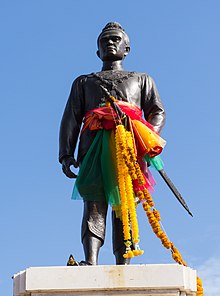Uthong
| King Ramathibodi I สมเด็จพระรามาธิบดีที่ ๑ | |||||
|---|---|---|---|---|---|
| King of Ayutthaya | |||||
 | |||||
| King of Ayutthaya | |||||
| Reign | 4 March 1351[1]–1369 | ||||
| Predecessor | Monarchy established | ||||
| Successor | Ramesuan | ||||
| Born | 10 March 1314[citation needed] | ||||
| Died | 1369 | ||||
| Issue | Ramesuan | ||||
| |||||
| House | Uthong Dynasty | ||||
King U-thong[2] (Thai: พระเจ้าอู่ทอง) or King Ramathibodi I (Thai: สมเด็จพระรามาธิบดีที่ ๑ ; 1314–1369) was the first king of the kingdom Ayutthaya (now part of Thailand),[3]: 222 reigning from 1351[4] to 1369. He was known as Prince U Thong (meaning "Golden Cradle") before he ascended to the throne in 1350. There are many theories about Uthong's background, including possibly being a descendant of Mangrai.[5]: 27 [6]
According to a better-known source, a seventeenth-century account by Dutchman Jeremias Van Vliet, a Renowned Legend stated that Ramatibodi was an ethnic Chinese, having sailed down from China. After succeeding in trade, he became influential enough to rule the city of Phetchaburi, a coastal town of the Gulf of Thailand, before travelling up to Ayutthaya.[citation needed]
Ramathibodi I established four Great Officers of State. These were the Ministry of the Interior (Wieng), the Ministry of the Treasury (Klang), the Ministry for the King's Household (Wang), and the Ministry of Agriculture (Na). He also codified the T'ai laws. Finally, he formed an alliance with the Ming Dynasty.[5]: 28
He established his own capital in the new city of Ayutthaya. King Ramathabodi's reign included Korat, Chantaburi, Tavoy, Tenasserim, and large parts of Malaya.[5]: 28
In 1352 he laid siege to Yasodharapura. He was successful the following year and placed one of his sons on the throne. However, they were only able to keep the throne until 1357, when the Khmers were able to regain it.[7]: 236
King Ramathibodi's death sparked a conflict over succession. Initially, his son King Ramesuan became ruler of Ayutthaya, but King Ramesuan later abdicated in favor of King Ramathibodi's brother-in-law, King Borommaracha I. This rivalry for the throne may have been peaceful or it may have been bloody.[5]: 29
References
- ^ Baker, Chris; Phongpaichit, Pasuk (2017). A History of Ayutthaya: Siam in the Early Modern World. Cambridge University Press. p. 43. ISBN 978-1-316-64113-2.
- ^ The Royal Institute. List of monarchs Ayutthaya Archived December 3, 2013, at the Wayback Machine. (in Thai)
- ^ Coedès, George (1968). Walter F. Vella (ed.). The Indianized States of Southeast Asia. trans.Susan Brown Cowing. University of Hawaii Press. ISBN 978-0-8248-0368-1.
- ^ Baker, Chris; Phongpaichit, Pasuk (2017). A History of Ayutthaya: Siam in the Early Modern World. Cambridge University Press. p. 43. ISBN 978-1-316-64113-2.
- ^ a b c d Chakrabongse, C., 1960, Lords of Life, London: Alvin Redman Limited
- ^ "The Siam Society Lecture: A History of Ayutthaya (28 June 2017)". Youtube. Retrieved 16 December 2021.
- ^ Cœdès, George (1968). The Indianized states of Southeast Asia. University of Hawaii Press. ISBN 9780824803681.
Bibliography
- Wyatt, David K., Thailand: A Short History, New Haven (Yale University), 2003. ISBN 0-300-08475-7
- Srisak Vallipodom, Sheikh Ahmad Qomi and the History of Siam, Cultural Center of the Islamic City, Republic of Iran, Bangkok 1995, page 209
- Plubplung Kongchana, The Persians in Ayutthaya, Institute of Asia Pacific Studies, Srinakharinwirot University.
